Feeding Deepthroat
Aug 19, 2019 14:08:21 #
While I’ve been willing to comment on the work of other people I have been reluctant to subject myself to their comments. Well here goes – Comments Welcome.
FEEDING DEEPTHROAT
House finches (Carpodacus mexicanus), which “were introduced into Long island in 1940” have been nesting in our porch awning for several years. “House finches tend to hang around humans, since they are a source of food, water and cover” and have a “marked tendency to return to the same nesting spot for subsequent broods and in subsequent years if they survive”. These images document five days of growth for the second brood this year.
After lowering our deck awning on 7/12 we were greeted by the sight of three silent house finch hatchlings, alone in a nest at the bottom of the awning – in the same place as last year. I feared that the parents would desert the hatchlings. However, ”Adults are pretty oblivious to humans, but may dodge into a nearby bush or tree”, and after several minutes pop finch returned, seemingly unconcerned by the new location of the awning, and began feeding the chicks by regurgitating food, often directly into the waiting mouths. Pic 1
Later that day strong winds made it necessary for me to retract the awning back to the house. I was concerned because “disturbing the nest around day 12 (after hatching) is likely to result in premature fledging”. I reasoned, however, that because the parents had spent significant effort and several days building and maintaining the nest when it was protected near the house, and had resumed their care when the awning was lowered, they would tolerate the disruption. Later that day I observed mom and pop visiting the hidden nest.
Two days later (7/14) I again lowered the awning and watched, relieved when pop returned to feed the chicks. Around day 5 hatchlings “can raise their butts to lip of nest to deposit feces”. This went on for several days, with both mom and pop sharing the feeding chores. Pics 2-6
Egg laying, typically “one egg laid each day”, results in hatchlings of different ages and sizes. The oldest (usually the largest) will, around day 10, “sometimes perch on edge of nest and fan wings”. Around day 12 they “appear fully feathered”.
We observed that “chicks begin begging loudly when parents approach”. At this stage of their development, around the 8th day after hatching “young beg so intensely that it looks almost like they are fighting”. Pic 7
This continued until one afternoon (7/17) I found only mom with one hatchling. The following morning (7/18) all were gone - all three had fledged. “Around day 16 they leave without parental provocation”.Pic 9
The proud parents Pic 10
NOTE: “bold text in quotes” is extracted from “All About House Finches (HOFI)”, at www.sialis.org. Because we are observing behavior of several birds of different ages the date of pictured behavior may not agree with the “date of hatching” in quotations.
FEEDING DEEPTHROAT
House finches (Carpodacus mexicanus), which “were introduced into Long island in 1940” have been nesting in our porch awning for several years. “House finches tend to hang around humans, since they are a source of food, water and cover” and have a “marked tendency to return to the same nesting spot for subsequent broods and in subsequent years if they survive”. These images document five days of growth for the second brood this year.
After lowering our deck awning on 7/12 we were greeted by the sight of three silent house finch hatchlings, alone in a nest at the bottom of the awning – in the same place as last year. I feared that the parents would desert the hatchlings. However, ”Adults are pretty oblivious to humans, but may dodge into a nearby bush or tree”, and after several minutes pop finch returned, seemingly unconcerned by the new location of the awning, and began feeding the chicks by regurgitating food, often directly into the waiting mouths. Pic 1
Later that day strong winds made it necessary for me to retract the awning back to the house. I was concerned because “disturbing the nest around day 12 (after hatching) is likely to result in premature fledging”. I reasoned, however, that because the parents had spent significant effort and several days building and maintaining the nest when it was protected near the house, and had resumed their care when the awning was lowered, they would tolerate the disruption. Later that day I observed mom and pop visiting the hidden nest.
Two days later (7/14) I again lowered the awning and watched, relieved when pop returned to feed the chicks. Around day 5 hatchlings “can raise their butts to lip of nest to deposit feces”. This went on for several days, with both mom and pop sharing the feeding chores. Pics 2-6
Egg laying, typically “one egg laid each day”, results in hatchlings of different ages and sizes. The oldest (usually the largest) will, around day 10, “sometimes perch on edge of nest and fan wings”. Around day 12 they “appear fully feathered”.
We observed that “chicks begin begging loudly when parents approach”. At this stage of their development, around the 8th day after hatching “young beg so intensely that it looks almost like they are fighting”. Pic 7
This continued until one afternoon (7/17) I found only mom with one hatchling. The following morning (7/18) all were gone - all three had fledged. “Around day 16 they leave without parental provocation”.Pic 9
The proud parents Pic 10
NOTE: “bold text in quotes” is extracted from “All About House Finches (HOFI)”, at www.sialis.org. Because we are observing behavior of several birds of different ages the date of pictured behavior may not agree with the “date of hatching” in quotations.
No 1
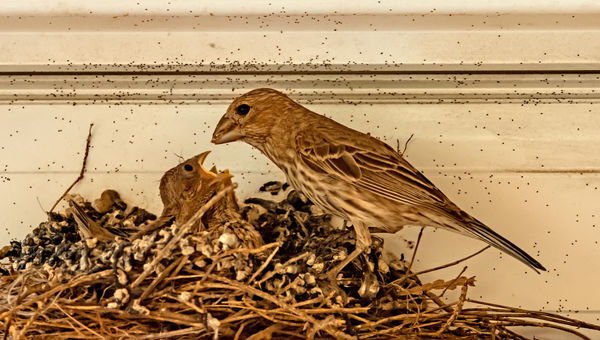
(Download)
No 2
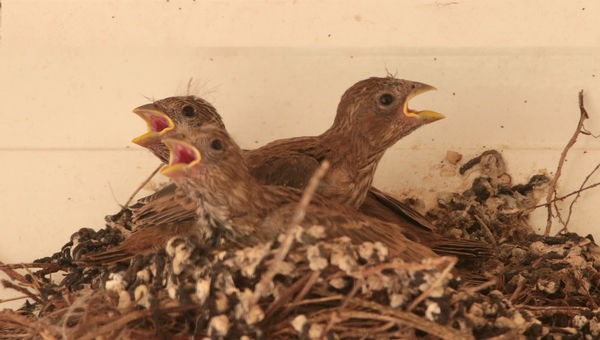
(Download)
No 3
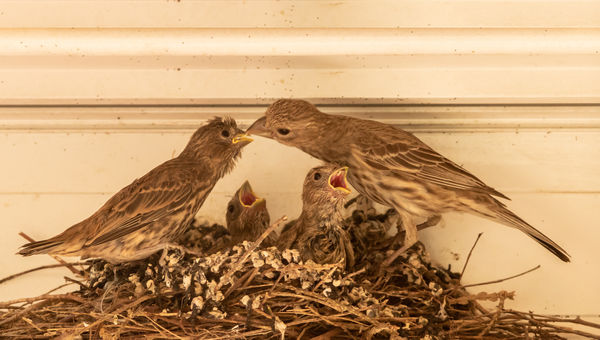
No 4
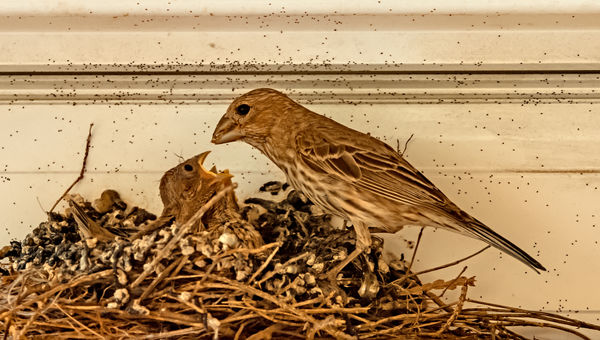
(Download)
No 5
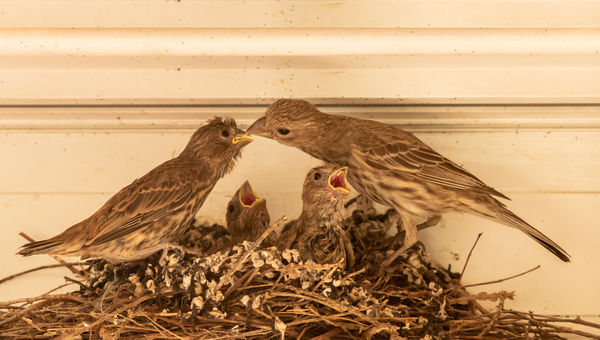
(Download)
No 6
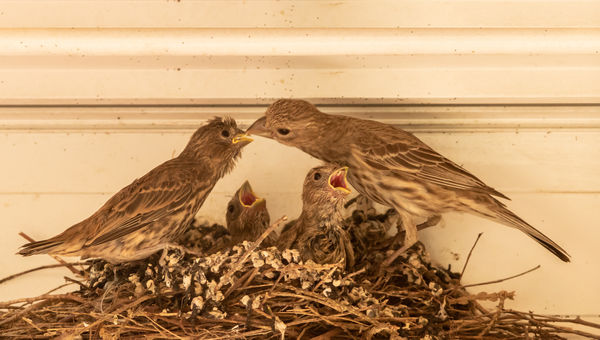
(Download)
No 7
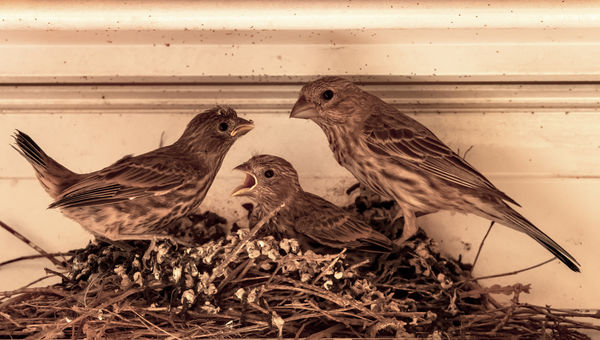
(Download)
No 8
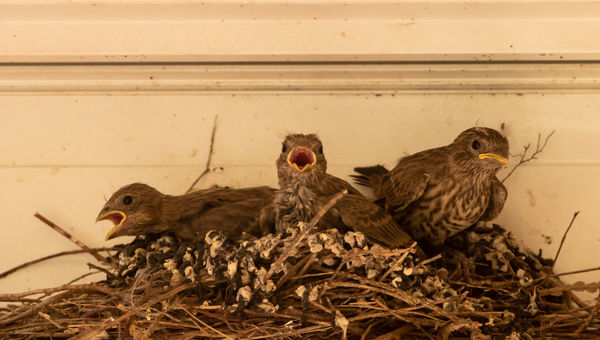
(Download)
No 9
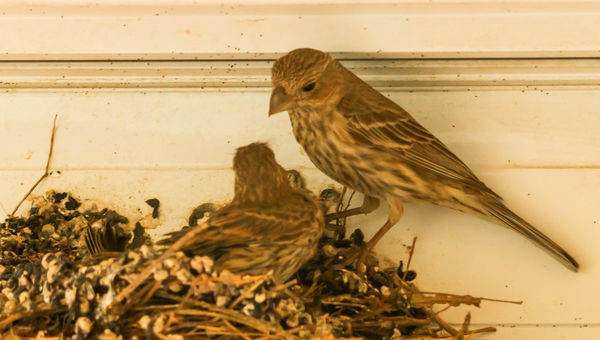
(Download)
No 10
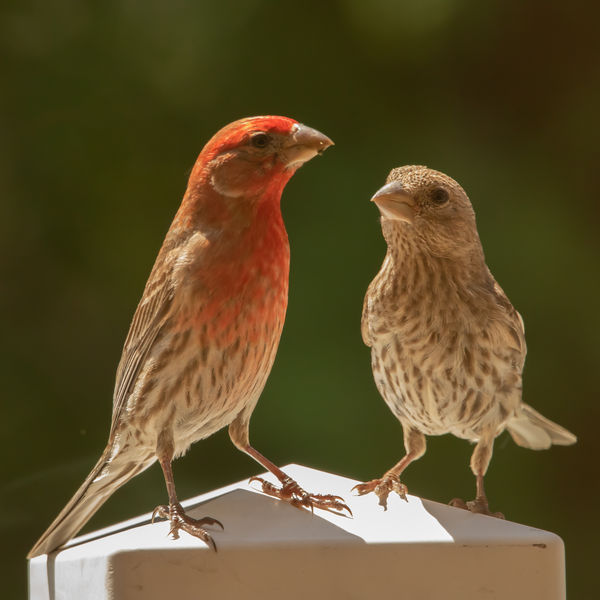
(Download)
Aug 19, 2019 14:19:54 #
wham121736 wrote:
Great story but NO images?While I’ve been willing to comment on the work of ... (show quote)
Aug 19, 2019 14:22:24 #
wham121736 wrote:
While I’ve been willing to comment on the work of ... (show quote)
Not sure how or why(no images)but be sure to click "Add Attachment" after choosing your files. Checking the (store original) will allow everyone to download and see greater detail. Way to take the plunge and thanks for such a great back story to go with photos we will see soon?!
Aug 19, 2019 14:27:35 #
PixelStan77 wrote:
Great story but NO images?
Sorry. Still figuring out how to post photos interspersed with text?
Aug 19, 2019 14:28:40 #
Umnak wrote:
Not sure how or why(no images)but be sure to click "Add Attachment" after choosing your files. Checking the (store original) will allow everyone to download and see greater detail. Way to take the plunge and thanks for such a great back story to go with photos we will see soon?!
You also need to wait for the upload or send verification.
If you leave the page before the verification is displayed, it will cancel.
Aug 19, 2019 14:37:51 #
wham121736 wrote:
While I’ve been willing to comment on the work of ... (show quote)
Outstanding series.
Aug 19, 2019 15:09:46 #
wham121736 wrote:
Sorry. Still figuring out how to post photos interspersed with text?
You cannot intersperse them on UHH, they have to be after the text.
Aug 19, 2019 15:13:21 #
Great series and narrative to explain them. Thanks, hope to hear from you again!
Aug 19, 2019 15:22:53 #
robertjerl wrote:
You cannot intersperse them on UHH, they have to be after the text.
Is there a limit on how much text can go in the title of each pic?
Aug 19, 2019 15:48:46 #
wham121736 wrote:
Is there a limit on how much text can go in the title of each pic?
Never tested that, I have done captions that went all the way across the page.
Tested it, about a line and a half across the page: https://www.uglyhedgehog.com/t-606661-1.html#10426522
Aug 20, 2019 01:42:44 #
D-5008
Loc: Raleigh, North Carolina
I am by no means an expert, but you may want to move the temperature more to the blue (lower?) in post processing.
Nice subjects and really like the parental shot at the end to finish with.
Nice subjects and really like the parental shot at the end to finish with.
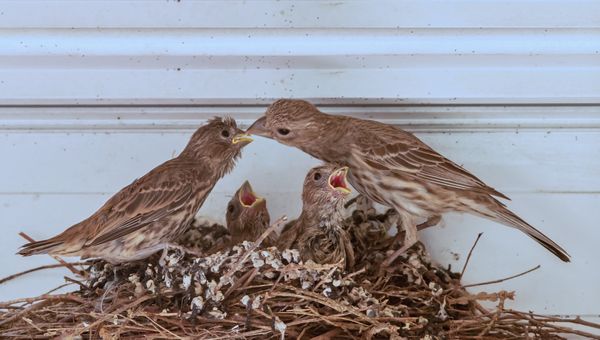
Aug 20, 2019 06:05:40 #
Aug 20, 2019 06:18:52 #
D-5008 wrote:
I am by no means an expert, but you may want to move the temperature more to the blue (lower?) in post processing.
Nice subjects and really like the parental shot at the end to finish with.
Nice subjects and really like the parental shot at the end to finish with.
The background material is tan so I don't think it would help.
If you want to reply, then register here. Registration is free and your account is created instantly, so you can post right away.






